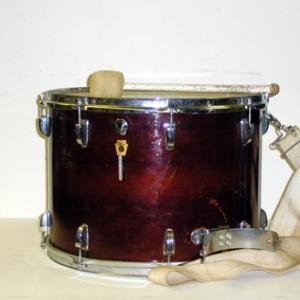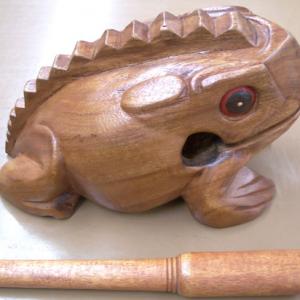College of Liberal Arts & Sciences
3D40.40 - Drums
The field drum has a pressure pad that applies pressure to the drum head, thus giving different tones. Some deadening or muffling of the drum may also be produced.
- Randy Worland, "Chladni Patterns on Drumheads: A 'Physics of Music' Experiment", TPT, Vol. 49, #1, Jan. 2011, p. 24.
- Adolf Cortel, "Simple Excitation of Standing Waves in Rubber Bands and Membranes", TPT, Vol. 42, April 2004, p. 239.
- Donald E. Hall and James Dearing, "Measuring Noise Exposure for a Drum Player", TPT, Vol. 21, # 2, Feb. 1983, p. 106.
- Thomas D. Rossing, "Acoustics of Percussion Instruments - Part II", TPT, Vol. 15, # 5, May 1977, p. 278.
- Thomas D. Rossing, "Acoustics of Percussion Instruments - Part I", TPT, Vol. 14, # 9, Dec. 1976, p. 546.
- Veronica P. Simonsen, Tathan Hale, Ingve Somonsen, "Eigenmodes of Fractal Drums: A Numerical Student Experiment", AJP, Vol. 92, #2, Feb. 2024, p. 115.
- Vern J. Ostdiek and Tom D. Brady, "Chladni Figures On a Tympani Head", AJP, Vol. 51, #5, May 1983, p. 474.
- A. Manzer, H. J. T. Smith, "Oscillations of a Circular Membrane", AJP, Vol. 40, # 1, Jan. 1972, p. 186.
- Alfred Leitner, "Vibrations of a Circular Membrane", AJP, Vol. 35, # 11, Nov. 1967, p. 1029.
- Andrew Morrison, Thomas D. Rossing, "The Extraordinary Sound of the Hang", Physics Today, March 2009, p. 66.
- Sir C. V. Ramin, "The Indian Musical Drums", Musical Acoustics, p. 179.
- Jearl Walker, "3.73, "Can You Hear the Shape of a Drum?", The Flying Circus of Physics Ed. 2, p. 174.
- Jearl Walker, "3.11, Bullfrog Croaking", The Flying Circus of Physics Ed. 2, p. 151.
- Neil. A. Downie, "Pneumatic Drum", Ink Sandwiches, Electric Worms and 37 Other experiments for Saturday Science, p. 57.
- Julius Sumner Miller, Q122 & A122, Millergrams II – Some More Enchanting Questions for Enquiring Minds, p. 15 & 79.
Disclaimer: These demonstrations are provided only for illustrative use by persons affiliated with The University of Iowa and only under the direction of a trained instructor or physicist. The University of Iowa is not responsible for demonstrations performed by those using their own equipment or who choose to use this reference material for their own purpose. The demonstrations included here are within the public domain and can be found in materials contained in libraries, bookstores, and through electronic sources. Performing all or any portion of any of these demonstrations, with or without revisions not depicted here entails inherent risks. These risks include, without limitation, bodily injury (and possibly death), including risks to health that may be temporary or permanent and that may exacerbate a pre-existing medical condition; and property loss or damage. Anyone performing any part of these demonstrations, even with revisions, knowingly and voluntarily assumes all risks associated with them.

